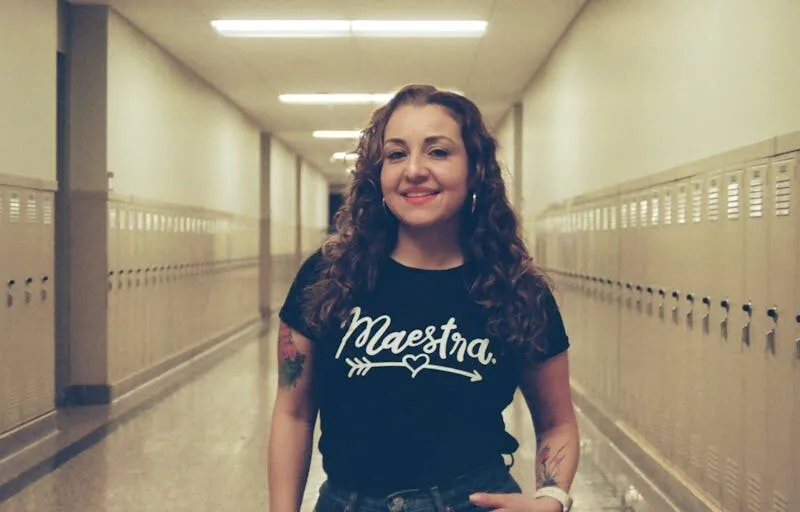Jennifer Nicholls is the owner, lead teacher “and cook, nurse and entertainment,” she joked, at Journey Preschool, a home-based early childhood education program that cares for a dozen children.
“Often we’re called providers, or babysitters, but we’re educators too,” she says.
That misconception often goes along with getting ignored by federal and state agencies’ rare efforts to improve early childhood education offerings. But thanks to a new $10 million initiative in Nicholls’ Montgomery County, Maryland, she and others have a shot at upping the quality of their programs.
This follows news about investments in early childhood programs garnering media attention in states including New Mexico, Vermont and California. But while Maryland may be dwarfed in size in both land mass and population compared to most other states, it is leading a trend to invest in early childhood programs — which could influence other states to do the same.
“Maryland had its blueprint for many years,” Hanna Melnick, director of early learning policy at the Learning Policy Institute, says. “They have a lot of big ambitions that are following a lot of the research, but there’s the pieces [to consider] of getting the funding in place. With the latest news, I’m not super surprised, but I am excited.”
Moves in Montgomery
The county, a suburb of Washington, D.C., unveiled in late September two new initiatives backed by the $10 million investment. The lion’s share of the funding, $6.1 million, is earmarked to expand Head Start, a necessity during a year of flat federal funding for the program and the current government shutdown that threatens to derail it.
Nicholls applied for the funding, and while she cannot expand her current 12 seats, if a student were to age out, that now-open spot could be eligible for Early Head Start funding.
“I’m a big proponent; I’m trying to create something equitable and accessible and affordable for families, because everyone benefits when parents can work,” she says. Early Head Start funding would be particularly helpful, she adds, because it supports community resources like medical screenings. Even if she has a single Early Head Start student, all 12 of her students would be able to use those resources.
The work in Montgomery County has been building over the last decade, spurred by several studies about the cost and quality of care, workforce compensation and a shared service proposal for child care providers. One standout statistic: Programs in the country have only enough infant and toddler seats to serve 19 percent of its under-2-years-old population. Programs can accommodate roughly 83 percent of children between 2 and 5 years old.
“When I showed the 19-percent data point, that was an eye-opening moment,” says Jennifer Arnaiz, senior administrator for early childhood services at Montgomery County. “It was a no-brainer to put some money into Early Head Start.”
“There’s a real focus on pre-K, and when we started looking at all the dollars we invest in 4-year-olds versus babies, it was evident the inequities that exist,” she adds. “I was saying, ‘No one loves the babies.’ If we want women to go back into the workforce, we have to provide high-quality child care.”
The remainder of the $10 million will go to a new $4 million loan program to help existing child care facilities add seats or improve the quality of their centers. That is in addition to the county’s expanded property-tax breaks, also approved last month, to help child care businesses stay open.
Nicholls, who already applied for the program, would use the funding to re-mulch, re-fence and update her outdoor playground.
“It’s 12 2-, 3- and 4-year-olds that have been using the same materials the last 10 years,” she says. “Quality matters and the materials they use matter. This [program] is a great opportunity to not just expand, but to really improve quality.”
The move in Montgomery County is concurrent with a yearslong effort by Maryland — and in some cases individual counties and cities — to push the Old Line State to be a leader in investing in early childhood education.
“The work has evolved into what I would say would be a model for other communities,” says Christy Tirrell-Corbin, executive director of the Center for Early Childhood Education and Intervention at the University of Maryland.
The state’s blueprint to increase educational investments over 10 years started in 2021. It comprises five pillars, with one being early childhood.
“I would say Maryland has a history of being strong in this space,” Tirrell-Corbin says. “Maybe we’re not getting The New York Times stories that New Mexico or Vermont are getting, but we have prioritized high-quality early care and education for a long time.”
A lot of the investment boils down to leadership and local community groups recognizing the potential for a high return on investment in early childhood programs.
“I think in Montgomery County they really do understand high-quality care is crucial to their economic success and that the early childhood care workforce is the ‘workforce behind the workforce,’” Tirrell-Corbin says, referring to the common adage that points out that without child care, many employees are unable to go to their own jobs and have to stay home with their children. “In some ways we could argue this initiative is almost a generational investment in both children, but also allowing parents to work.”
Part of a Larger Trend
Montgomery County is not the only entity to implement child-focused policies lately. But it could be part of a larger movement in the absence of federal funding. During the Biden administration, the Build Back Better bill, which would have overhauled early childhood education, failed to pass.
And with the Trump administration resisting increasing funding to programs like Head Start, while cutting that of other social programs like Medicaid, it could push states, counties and cities to put more of their own money into programs that were once almost fully funded by the federal government.
“The federal government is either holding steady or pulling back [in social programs] and as a result we’ve seen states and localities say, ‘This puts the onus on us to build,’” says Lynn Karoly, a senior economist at the nonprofit think tank RAND Corporation. “In the last year or two, states — in the absence of significant federal investment — have had to find other funds.”
How exactly the entities go about that funding widely varies. Oklahoma, one of the first in the nation to invest in universal pre-K nearly 40 years ago, did so through a school finance formula funded through the state. Georgia used a tax on its lottery system for its pre-K program, while in Ohio, Cincinnati had a levy within its school tax district to expand preschool access. California famously imposed a tax on tobacco in 1988, but those revenues have declined with the decreasing popularity of smoking. It has now shifted to a tax on cannabis, though that brought its own controversy. Melnick of the Learning Policy Institute, herself a California resident, says state tax programs can be volatile; officials need to consider additional, long-term plans.
Montgomery County’s initiative takes a different route. The $6.1 million toward expanding Early Head Start and Head Start programs is a grant from the Head Start agency itself. The remaining $4 million ECE Facility Loan program comes from a partnership between the county and Reinvestment Fund, a Philadelphia-based community development financial institution.
“Usually every jurisdiction is trying to figure out, given the mix of how we generate revenue already, ‘what is a source we can divert?’” Karoly adds. “But others are looking for something new. And again, that’s largely because the federal government hasn’t really come to the rescue.”
Many states are expanding their pre-K programs: California’s universal pre-K program, for instance, took effect for the 2025-26 school year. But Melnick points out that when it comes to an earlier level of education, there’s still work to be done. Early childhood programs are typically much more costly due to the large number of personnel needed. One teacher in an elementary school can cover 20 students, for example, while in many states, regulations dictate that one staffer can only cover four babies in an early education center.
“A couple of years ago we were in a different spot and that’s where you saw more of the bigger thinking with toddler care and taking the bigger step, because it is a long-term investment,” Melnick says. “Pre-K [legislation] is just less expensive. You can serve so many more kids and get credit as legislators of a larger expansion with the same dollars.”
Future Domino Effect?
It is hard to estimate whether Montgomery County — or any entity — could have an impact on other jurisdictions’ early childhood investments, Karoly says. Efforts are tied to the cyclical nature of the economy, with economic windfalls bringing in more future-focused programs, like universal child care. On the flip side, economic downturns cause local and state governments to concentrate on simply sustaining their current programs and focus on those most in need, such as economically disadvantaged students in Head Start.
“We don’t know where the economy is going, so it’s hard to have the crystal ball to say ‘We are going to see expansion with investment,’” Karoly says. “Some communities are maintaining their commitment and holding on or, to the extent there is a pullback, they’ll focus on those hoping they’ll benefit the most.”
Arnaiz gives a simple piece of advice for those looking to mimic the Montgomery County investments.
“We are doing a real systems change, and in order to do that, we have to see what’s our North Star and backtrack, leading us toward what the ultimate goal is,” she says. She thinks that surveys, similar to the one in Montgomery County that became a catalyst to invest in child care programs, are particularly helpful due to the mass amount of data they provide.
At the very least, Melnick says, recent state efforts get the conversation rolling for early childhood education advocates.
“The circumstances [for each state] are unique but it’s exciting to see an entire state rally around child care,” she says. “The practicalities are going to be different, but you can look at the campaign, the messaging, and that inspiration,” Melnick says. “I do think there’s something important about the snowball effect, even if it is a slow-growing snowball.”


